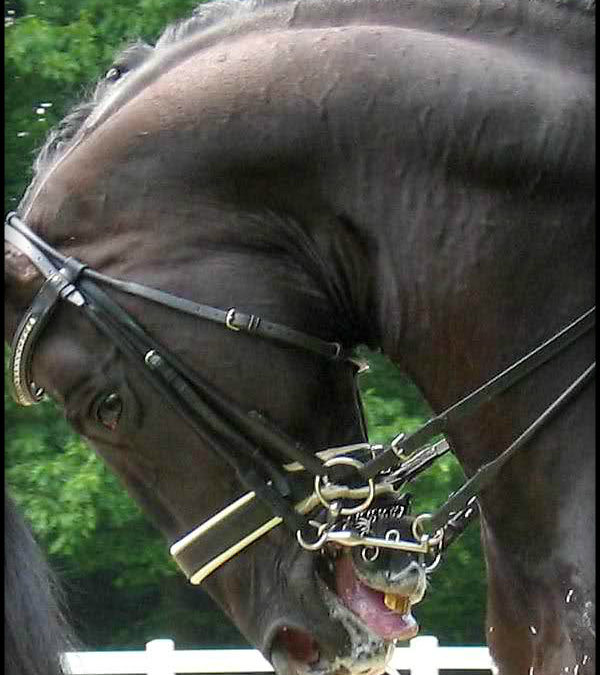I often feel like I am looking at something entirely different to many of my peers, to so many of my friends and to what sometimes feels like a majority of the horse world.
 How can we say we are against this kind of riding but scores say otherwise in competition?
How can we say we are against this kind of riding but scores say otherwise in competition?
The fact is that people have become so used to seeing an overbent horse that it has become desirable. It has become the “norm”. When you look at this photo, do you see a relaxed horse? Do you see the horse displaying it’s “natural beauty and grace” – which is desirable in dressage? What do you see?
Myofacial release…osteopathy…physio therapy…remedial hoof treatment…
So many owners with the best intentions have spent their hard earned money on ensuring their horses get the best professional care just to find they are having to call these wonderful people out for regular call outs for the same ailment.
I speak to alot of people who are unaware of how their riding can have negative implications on their horses’ health. One of my major niggles, is the overbending of the horse’s neck (aka an overbent horse!)
Let’s look into this a little further…

Hyperflexion
Now, I see alot of campaigning against the FEI and numerous organisations worldwide for many reasons, especially the use of Rolkur. This is encouraging!
How many posts, how many magazine covers, how many pictures – how many top competition riders have you seen with horses pulled in, with all kinds of contraptions? How many angry posts about the mistreatment of horses, showing them with chins pinned to their chests – even some with blood in their mouths?
I completely support the cessation of this kind of riding and I think it is long overdue that the authoritative bodies take notice and (hopefully!) take action.
However… I also see numerous trainers and instructors encouraging and actively teaching students to ride with their horses, most regularly, unnaturally curled at the C2 and C3 vertebrae as part of common practice. Sure…some of them aren’t “behind the vertical” but their necks are still distinctly swanned in an unnatural poise. Too many are misinformed about where the “vertical” actually is and what is best for the horse, anatomically speaking.
So where is this unnatural bend?
 It has to be pointed out that the “poll” as we reference it, is the occipital protrusion at the back of the horse’s skull. Many will refer to it as the poll joint between the atlas (C1) and the skull. (Image: Google)
It has to be pointed out that the “poll” as we reference it, is the occipital protrusion at the back of the horse’s skull. Many will refer to it as the poll joint between the atlas (C1) and the skull. (Image: Google)

The Vertical
Ask a rider where the vertical is. Often, people believe the vertical is an imaginary line from the horse’s forehead down to the ground. I am in agreement with this. However, where a horse should naturally carry themselves in relation to this imaginary line is another matter.
This horse here is behind the vertical. The hind end is not engaged and it is heavy on the forehand. Yet, because horses are regularly seen pulled into an outline on the show circuit, it is too often deemed acceptable – even desirable.
If a horse’s highest point is the poll whilst in movement, naturally, the nose will be just in front of the vertical. This is because the horse’s face slopes slightly.
A good guide to having your horse in the correct position is to see the cheek strap of a conventional bridle angled vertically down the face whilst riding. In this position the horse’s highest point should be the poll and the nose will be slightly over that vertical line!

So why do horses constantly win competitions when they are behind the vertical? Why is it ok for them to be an overbent horse? Why do we still see those who are against this kind of riding, allowing it to happen or even teach it? How is it ok for some and not for others?
I do not find this acceptable. It saddens me to see riders prioritise their competition schedules, entering tests beyond theirs or their horses’ capabilities, instead of focusing on the training and well being of their horses. As a new season approaches, what are your thoughts?
